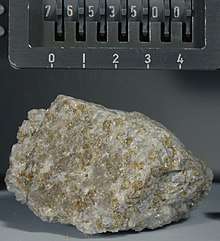Troctolite 76535
Troctolite 76535 is a lunar sample discovered and collected on the Apollo 17 mission in 1972 in the Taurus–Littrow valley. It has a mass of about 156 grams and is about 5 centimeters across at its widest point. It was collected by geologist astronaut Harrison Schmitt as part of a "rake sample" of lunar soil at Geology Station 6, near the base of the North Massif.[1]

Description
Troctolite 76535 is a coarse-grained plutonic rock that is believed to have had a slow cooling history. The rock originates from early in the Moon's history. Geologists have described it as a coarse-grained olivine-plagioclase cumulate with a granular polygonal texture.[2]
Olivine and plagioclase are of about equal quantities within 76535, while the remaining approximate 4% is made up of primarily orthopyroxene. Studies have shown that the rock is plutonic in origin and originates from about the middle to lower crust of the Moon.[3]
Investigations have shown that the rock may have formed as a cumulate at depth, thus possibly making the sample an important link in the understanding of the geologic timeline of the Moon.[4]
As Troctolite 76535 is the oldest known unshocked lunar rock, it has been used for thermochronological calculations in order to determine whether the Moon formed a metallic core or generated a core dynamo. The results of these studies have been shown to support the core dynamo hypothesis.[5]
According to early studies, 76535 shows evidence of having cooled slowly at a depth of about 10–20 kilometers (6–12 miles), as well as reequilibration and annealing.[6] Later work proved that the rock formed at a depth of 47 kilometers.[7]
Troctolite 76535 has been called the most interesting sample returned from the Moon.[2]
References
- "Lunar Sample 76535". Lunar and Planetary Institute, Lunar Sample Atlas. Retrieved 14 November 2014.
- "76535 Troctolite" (PDF). National Aeronautics and Space Administration. Retrieved 26 October 2010.
- Domeneghetti, M.C.; et al. (2001). "Complex Cooling Histories of Lunar Troctolite 76535 and Stillwater Orthopyroxenite SC-936" (PDF). Lunar and Planetary Science XXXII (2001). Retrieved 24 November 2010.
- Bogard, D. D.; et al. (May 1975). "76535: An old lunar rock". Earth and Planetary Science Letters. 26 (1): 69–80. Bibcode:1975E&PSL..26...69B. doi:10.1016/0012-821X(75)90178-8.
- Garrick-Bethell, Ian; et al. (January 2009). "Early Lunar Magnetism". Science. 323 (5912): 356–359. Bibcode:2009Sci...323..356G. doi:10.1126/science.1166804. PMID 19150839.
- Ahrens, L. H. (1980). Chemistry of the moon. ISBN 978-0-08-020287-7.
- Schwartz, J. M.; McCallum, I. S. (1999). "Inferred Depths of Formation of Spinel Cataclasites and Troctolitic Granulite, 76535 Using New Thermodynamic Data for Cr-Spinel". Lunar and Planetary Science Conference: 1308. Bibcode:1999LPI....30.1308S.